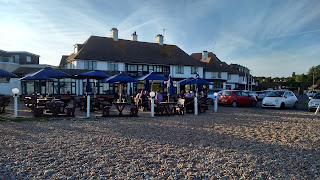 |
| Bavarian Weißbier |
However the style of beer I am referring to almost died out in both countries, but made an astonishing comeback during the final quarter of the last century. The beer style, of course, is wheat beer, and the countries referred to above are Belgium and Germany. Wheat beer is known in these countries as Witbier or Weiss (Weißbier) Bier, respectively.
First a few definitions and background information:
Wheat beer is beer which is brewed with a large proportion of wheat relative to the amount of malted barley; it is usually top-fermented. Two common varieties of wheat beer are Weißbier (German – "white beer") based on the German tradition of mixing at least 50% wheat to barley malt to make a light coloured top-fermenting beer, and Witbier (Dutch – "white beer") based on the Belgian tradition of using flavourings such as coriander and orange peel. Belgian white beers are often made with raw un-malted wheat, as opposed to the malted wheat used in other countries.
Witbier
 |
| Hoegaarden |
The style was famously revived in 1965, by Pierre Celis at the Hoegaarden Brewery in Belgium. Witbiers beers often have a somewhat sour taste due to the presence of lactic acid, and also, the suspended yeast in the beer causes some continuing fermentation in the bottle.
Weizenbier
Weizenbier ("wheat beer"), is a style of beer well known throughout Germany; but in the southern parts of Bavaria, such beers are usually referred to by the term Weißbier (literally "white beer”). In the Bavarian version, a significant proportion of the malted barley is replaced with malted wheat. By law, Weißbiers brewed in Germany must be top-fermented, and specialized strains of yeast are used which produce, as by-products of fermentation, the characteristic banana and clove aroma and flavours which are so typical of these beers.
Another explanation for the term Weißbier is because, at the time of its inception, it was much paler in colour than the typical Munich brown beers. The terms Hefeweizen ("yeast wheat") or Hefeweißbier refer to wheat beer in its traditional, unfiltered form. The term Kristallweizen ("crystal wheat"), or kristall Weiß ("crystal white beer"), refers to a wheat beer that is filtered to remove the yeast from suspension. Additionally, the filtration process removes wheat proteins present in the beer which contribute to its cloudy appearance. Unfiltered versions are much more popular, and the "crystal" versions are decried by beer purists.
 |
| Ayinger Weißbier |
Weißbier is available in a number of other forms including Dunkelweizen ("dark wheat") and Weizenstarkbier ("strong wheat beer"), commonly referred to as Weizenbock. The dark wheat varieties are made with darker, more highly kilned malts (both wheat and barley). The Weizenbocks typically have a much higher alcohol content than their lighter counterparts.
Berliner Weisse
While the brewers in southern Germany rely on yeast for the flavour and aroma of their wheat beers, brewers in northern Germany use a different technique. Berliner Weisse is fermented with ale yeast and Lactobacillus delbruckii which creates an incredibly sour beer. The bacterium contributes a dominant mouth-puckering sourness. Otherwise this beer is light in character and very effervescent. Some fans of this rare style like to sweeten it with flavoured syrups. Whilst this might make the beer more drinkable it should definitely be tried on its own first.

English Wheat Beers
A few English brewers have turned their hands to knocking out a wheat beer or two. Most noteworthy amongst them is renowned Sussex brewery, Harvey’s of Lewes. Harvey’s have been brewing their Copperwheat every year since 2001.This 4.8% pale beer appears in June as a seasonal beer. Unlike most of its continental counterparts, Copperwheat is filtered; it is also brewed using Harvey’s own yeast strain, but still manages to achieve that distinctive wheat beer taste.
The other best known English wheat beer is Clouded Yellow, from St Austell Brewery in Cornwall, which is available in bottled form only, but there are quite a few other breweries producing the style. All these examples though are very much niche beers and it is doubtful that the style will ever catch on in the way it has in Bavaria and Belgium.
Glassware
Wheat beers tend to foam a lot, especially if poured quickly. In pubs, if the bottle is handed to the customer for self pouring, it is customary for the glass to be taken to the patron wet or with a bit of water in the bottom to be swirled around to wet the entire glass to keep the beer from foaming excessively.
In Germany a weizen glass is used to serve wheat beer.. The glass is narrow at the bottom and slightly wider at the top; the width both releasing aroma, and providing room for the often thick, fluffy heads produced by the beer.It tends to be taller than a pint glass, and generally holds 500 millilitres with room for the head. In other countries, such as Belgium, the glass may be 250 ml or 330 ml.
Right that’s more than enough technical and background information, but knowing that, in Bavaria in particular, the yeast strains used to ferment the beer are responsible for the clove, banana and bubble gum flavours of Weißbier still does little to endear me to the style. It is not that I don’t like these flavours, per se; it is just that I find them rather off-putting in beer!
Some people might say I don’t know what I’m missing, and maybe they’re right, but unless I have some sort of “Road to Damascus” like conversion, I don’t think I’ll be raising a glass of wheat beer anytime soon.






















